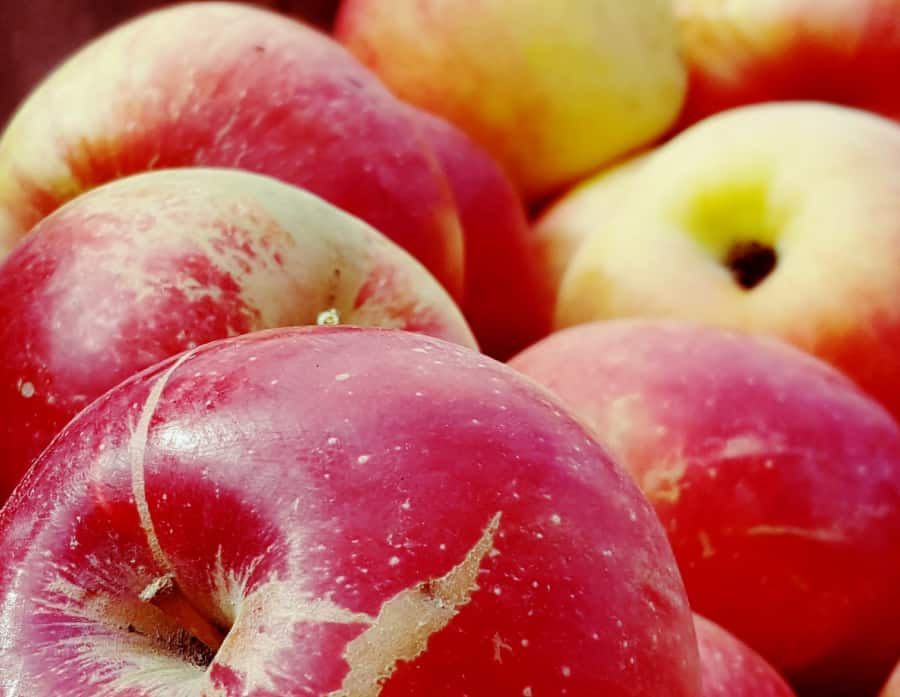Growing apples is often the vision of nearly every homeowner. Even those who do little or no gardening enjoy having an apple tree or two. Picking fresh, homegrown apples is a treat beyond words. I myself have long been fascinated by fruit trees, and apples are a specialty.
There are more than 7,500 varieties of apples across the world, but only a few hundred are possible to find in North America. Looking at your local nursery, the number is even less. Most nurseries do not carry more than 5 to 10 varieties. Growing apples can seem like a daunting task, especially for new homeowners and young gardeners, but it is easier than you think.
Brief History of Apples
Now, I could write all day about the varied history of the U.S.’s most popular fruit, but we have more to cover than just history. Apples are thought to have first originated in present-day Kazakhstan, in Central Asia. From there, they have travelled across the globe. Arriving in the Americas with the colonists, apples are cultivated commercially in 35 states.
Most of know the story of John Chapman (Johnny Appleseed), but few realize how improbable the tale really is. It is true that John started nurseries in several Midwest states, and grew and grafted apple trees, but throwing seed out and getting apple trees with edible fruit is difficult. The chance of getting a good apple from its seed is about 1 in 80,000.
Grafting
All the apple trees you buy from the nursery will be grafted onto a rootstock. If you look near the base of a young apple tree in the nursery, you can see where the graft union is. Just look for a bulge or irregular shaped growth about 4 to 8 inches above the soil line. Branches or scions are cut from good trees and then grafted onto rootstock.
Rootstalks are used to control the size and vigor of the overall tree. Seedling rootstocks grafted with any scion, will produce 30 to 40 foot trees, without regular pruning. But dwarfing or semi-dwarf rootstalks are used to keep the trees in a more manageable size. If you live in Zones 3 to 6, you most likely will be buying apple trees with a semi-dwarf rootstalk, while warmer regions often use fully dwarf rootstalks.
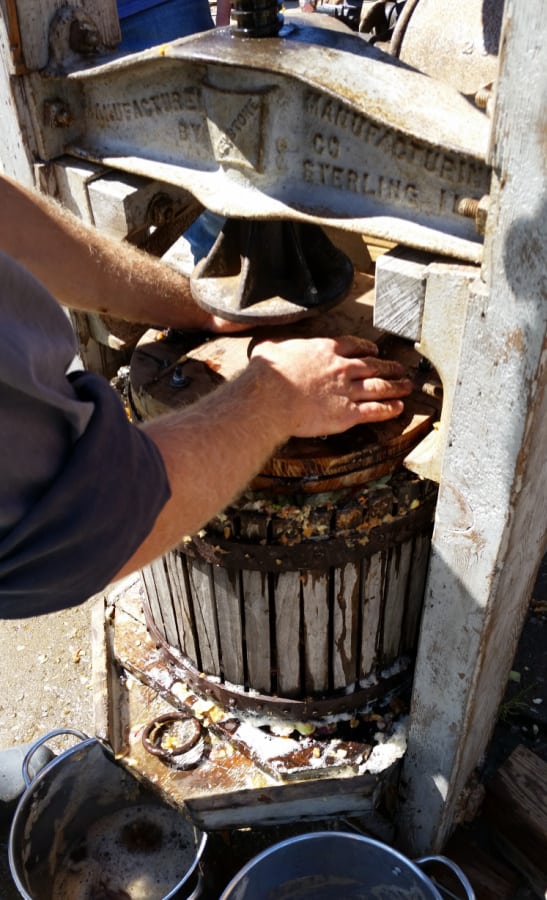
Uses of Apples
Apples are most widely known for fresh eating, baking, apple juice, and cider. But there are many more reasons to grow apples in your own garden. Apple butter and applesauce are 2 very good reasons to keep apples around. These 2 methods of preserving the pulp of apples are excellent for a cold winter’s night, when no fruit is available.
Apple juice, cider, and hard cider are all big reasons to grow your own varieties of apples. I recently tried apple soda from a local store and found it a pleasant alternative to the more bland juice. If you or a neighbor has a cider press, then you can invite friends and family to an old-time pressing, making cider. Almost every old farm or homestead has at least one large apple tree.
Corkscrewed and dried apples rings can even be used to decorate Christmas trees or wreaths as an alternative to machine made garland. Sprinkle with cinnamon oil or clove oil as they are drying for an extra touch.
Choosing a Variety of Apple to Grow
What you really need to know before choosing the variety is to know where to plant them, and where to get them. You can plant apples almost anywhere. Try tucking one alongside a fence or screen and espalier it. Or put 3 together in a flower bed. Or plant columnar cultivars in large containers on the deck. Maybe you have a spot for a large orchard with 10 or more trees.
Here at Grimm’s Gardens we regularly keep between 6 and 12 varieties of apples in stock. If you are not near us, or we do not carry the variety you want, look to your local nursery of mail-order catalog for varieties. There are some mail-order companies that specialize in antique apples like Cox’ Orange Pippin, Arkansas Black, and Ben Davies.
Let us have a look at some different varieties.
Popular Apple Varieties
Sometimes, varieites become popular not because of taste, but becuase of familiarity. If something is pushed as easy to grow, and easy to harvest, or is found often in grocery stores, people learn it quickly and look for it.
Here are the top 10 apple varieties in the United States.
- Red Delicious – Best for fresh eating from the store or off the tree.
- McIntosh – red in color and best for fresh eating or juicing.
- Golden or Yellow Delicious – this variety is sweet and mild and can be used in salads, for baking, or just eaten fresh.
- Gala – you can eat it raw, chop it up, make cider, or bake with this variety from New Zealand.
- Granny Smith – if you want tart and crisp, this is the apple for you. It is excellent for baking.
- Fuji – originating in Japan, this variety if very popular because of its diversity – use it for baking, salads, or eat fresh.
- Braeburn – another variety from New Zealand, it is excellent for baking.
- Pink Lady – one of my favorite varieties, it is excellent eaten raw or chopped into salads.
- Honeycrisp – I was working in Minnesota when this variety first came on the scene. It is now the state fruit of Minnesota. Delicious!
- Empire – from New York, this apple is wonderful eaten fresh, baked, or made into cider.
Other Easy-to-Find Apple Varieties
The above are the most popular varieties. But there are many others that can be found easily at nurseries or on store shelves. Let us look a sampling of them.
- Sweet Sixteen
- Cortland
- Snow Sweet
- Liberty
- Zestar!
- Jonathan
- Johnagold
- Winesap
- Candy Crisp
Antique Apples
There are many thousands of apple trees that were grown in colonial times and that have been mostly forgotten by consumers. But a few of us still remember names we heard from our grandparent’s or read of in old stories. Following is a list of some of the many antique apples.
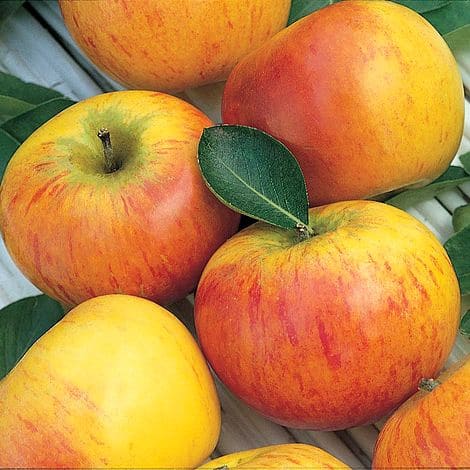
- Arkansas Black
- Baldwin
- Black Twig
- Cinnamon Spice
- Cox Orange Pippin
- Gravenstein
- Grime’s Golden
- Mountain Rose
- Ribston Pippin
- Roxbury Russet
- Snow Fameuse
- Sops-N-Wine
- Spitzenburg
- Winter Banana
- Wolf River 1881
Pollination Requirements
Another very important thing to know about picking an apple tree is pollination. An apple tree cannot pollinate itself. You must have 2 different varieties of apples, and they need to be in the same pollination group, which means that their bloom times overlap enough to allow pollinators to spread pollen from the flowers of the trees around.
There are 4 groups of pollination: A, B, C, and D. Most nurseries will list which pollinator group a specific variety falls into, or list other varieties which will pollinate it. Some nurseries only sell varieties which pollinate each other. Crabapple trees have a longer bloom period than apples and are often recommended to be planted alongside apples for pollination.
Planting Your Apple Tree
Every year, I look at trees that have been either planted in the wrong place or planted incorrectly. But what does it mean to plant a tree incorrectly? It means that the tree was planted too deep in the ground. Recently, I diagnosed a dying maple tree that had been planted 9 inches too deep!
When it comes to planting trees, whether fruit or shade, you cannot be more precise than to get it right. Improper planting will affect the future survivability of your tree. What we need to know when planting is location, how to dig the hole, staking, and watering.
Where to Plant Your Apple Tree
Like I said above, you can plant an apple tree almost anywhere. The roots are not invasive, meaning that they pose no threat to basement walls or sidewalks. There are even columnar cultivars from nurseries that can be grown in large pots on the patio.
One thing I stress to every client wanting to plant trees, is that trees like to be close to one another. Even if they are different species. Trees, through interconnected root grafts, chemical signaling, and electrical ground currents, send messages back and forth on weather, incoming pest attacks or diseases, and even fruit production.
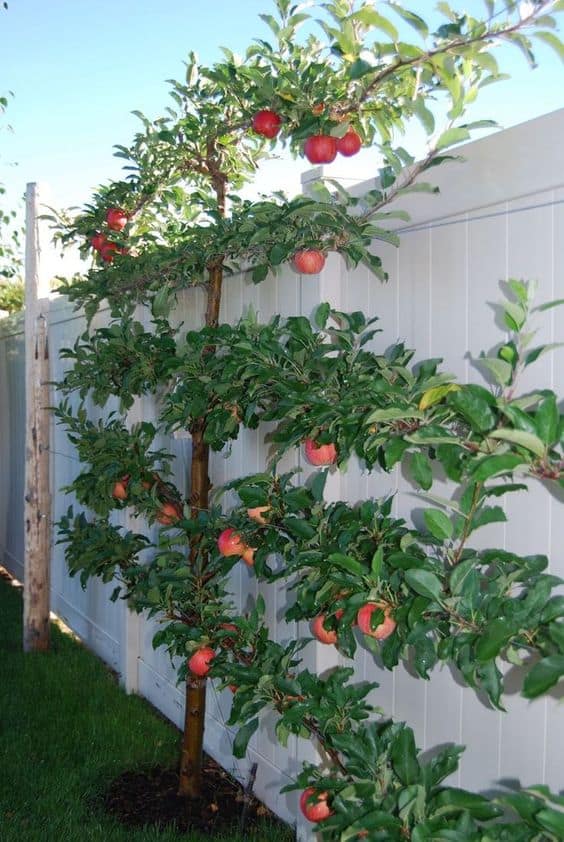
There are 4 planting areas or methods that can help you determine where to plant your apple tree.
- Traditional Orchard – here you plant several rows of fruit trees (can be all apple or other kind, or mixed) in a large block of trees. They are usually spaced 15 to 30 feet apart.
- Fruit Tree Guild – this is where you can have fun in your plantings. Planting your apple tree(s) in a guild means pairing them with annuals, perennials, shrubs, and other trees, usually edibles. It creates a balanced approach to gardening where each plant contributes to the health and well-being of all the other plants.
- Espalier – this is an artistic form of growing fruit trees along a wall, screen, or fence. Trees are pruned and weighted to be shaped to grow in minimal space, while yielding maximum fruit potential.
- Container – planting your apple trees in containers may seem daunting, but special cultivars can be planted in 30 to 50 gallon containers on a deck, patio, or even a driveway!
Site Requirements
Apple trees grow best in full sun, so plant your tree where it can receive 6 to 10 hours of sunlight per day in the growing season. If you follow the path of the sun during the course of the day, you should be able to locate a suitable spot. Also, even though trees like to be close together, an area of stagnant air can lead to leaf diseases such as powdery mildew or bacterial leaf spot.
Being quite adaptable to many soils, you should be able to plant your tree almost anywhere. I would suggest staying away from soils with really high or low pH, or any contaminated with chemicals, oil, or heavy metals. You should get a soil test before planting.
Digging the Hole
Now there are many myths surrounding the planting of trees. Over my tenure at Grimm’s Gardens, I have attended many symposiums, lectures, and studies on the growth and planting of trees. I have planted hundreds of trees for customers. The number 1 problem with trees happens at planting.
If you do not get your hole dug correctly, it can affect the overall health of the tree for years to come. The main myth is that you are supposed to dig the hole to 3 times the size of the root ball. What happens is that when you dig such a large hole, the roots from the tree sit in that modified soil structure and do not penetrate the surrounding soil.
Dig the hole slightly larger than that of the root ball. The following image shows the depth and size of the hole needed.
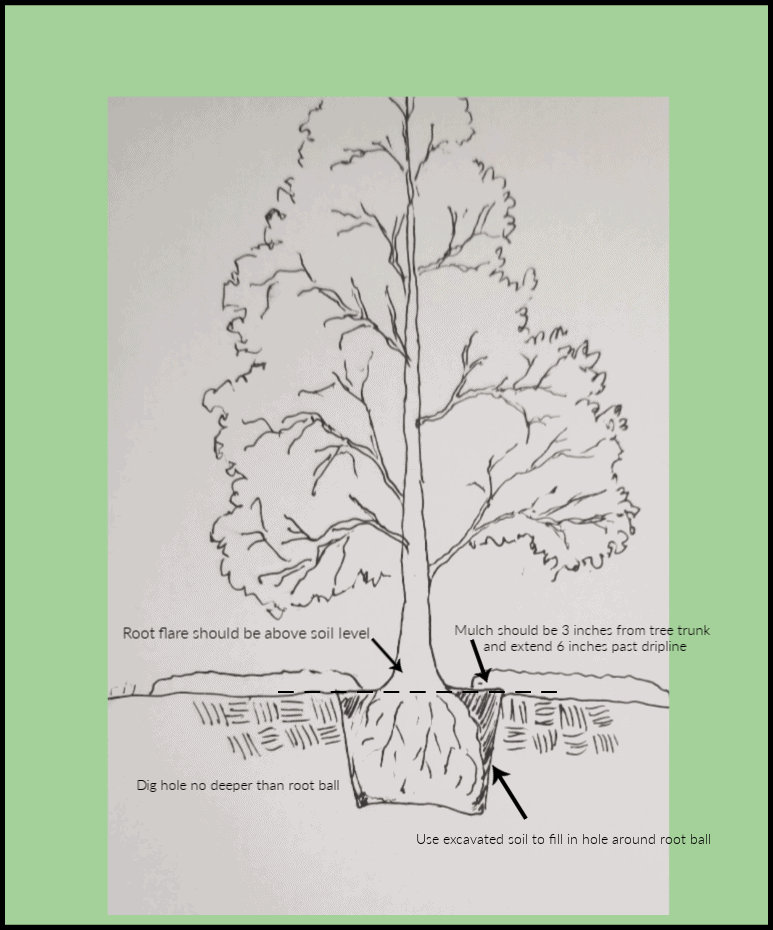
Staking Apple Trees
When newly planted, apple trees should be staked to allow the roots to stabilize into the surrounding soil. This can be done most easily with a fiberglass pole and a rubber strap. The pole should be place pointing from the southeast to the northwest, along the trunk of the tree.
Fruit trees are also often attacked by animal pests in winter. Rabbits and deer may feed on the young fruit trees as they are growing, so a protective cage is necessary, if your area is not fenced.
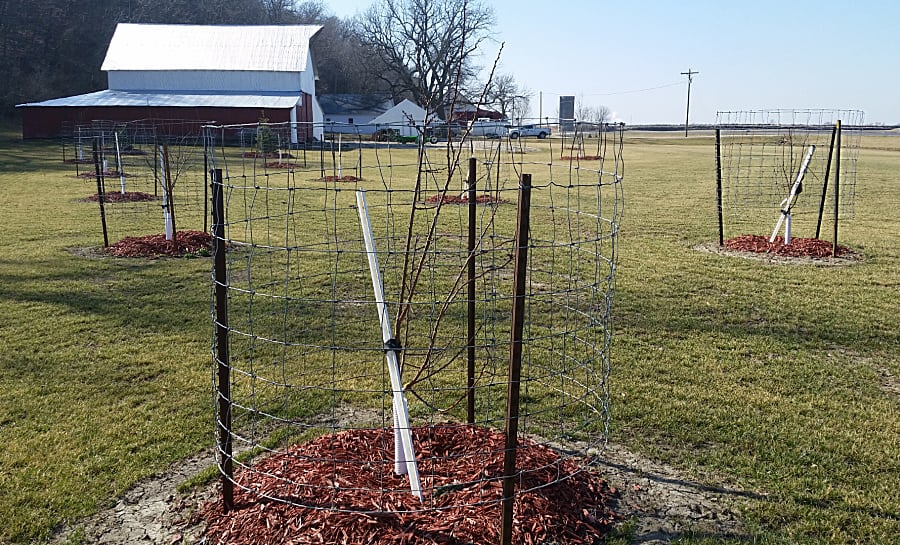
Watering Your Apple Tree
Newly planted trees can use a lot of water. But if you plant your trees in spring or fall, when temperatures are cooler, you will have less stress from high rates of transpiration and evaporation. When you are planting your apples, make sure you have a reliable source of water nearby. You do not want to be hauling water up the hill in buckets.
If you have are planting more than 5 trees, you may decide to add an irrigation system for the trees. I would recommend a sprinkler system, that is watering both the surrounding soil and the trees. This method keeps the ground moist, allowing the tree’s root ball to keep its acquired moisture, rather than have it taken up by drier soil around.
However, you should water your new trees daily during the first 2 weeks after planting, unless the weather is cool and rainy. New trees should receive a 1:1 ratio of water to container size. For example, a tree in a 5 gallon container should get 5 gallons of water daily for the first 2 weeks. After the initial 2 weeks, switch to watering 2 times per week for 6 weeks. Then water bi-weekly as needed through the rest of the growing season. In winter, if the weather is dry or warm, water every other week to keep the roots from drying out completely.
Pests and Diseases of Apple Trees
While apples are certainly delicious and everyone needs them in their gardens, they are also one of the most pest ridden trees. Being a member of the Rose Family of plants, there is a long list of diseases and pests that affect them. I have written previously in depth about these problems in Growing Fruit – Problems of Apples and Pears. But here is a list of some of the more problematic pests and diseases to watch for on your own apple trees.
Insects on Apple Trees
- Plum Curculio
- Codling Moth
- Oriental Fruit Moth
- Lesser Appleworm Moth
- Oblique-Banded Leafroller Moth
- Red-Banded Leafroller Moth
- Green Fruitworm Moth
- Woolly Apple Aphid
- San Jose Scale
- Japanese Beetle
- Dogwood Borer
Diseases on Apple Trees
- Apple Scab
- Fire Blight
- Powdery Mildew
- Sooty Blotch & Flyspeck
- Cedar Apple Rust
Pruning Apple Trees
When you first plant your apple trees, you often forget that they will need pruned at some point. Let me tell you, it can be both difficult and worrisome when you are first learning to prune. Many of my customers, who ask for lessons on pruning, often just call in the end and ask for me to come prune.
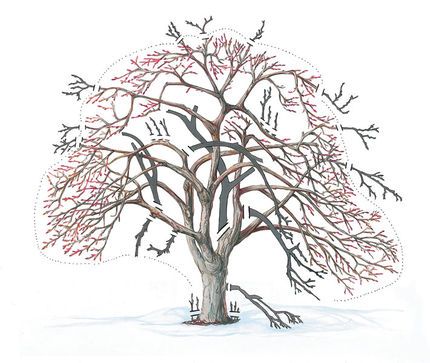
For me, I had a great high school education which included lessons on pruning fruit trees, followed by career paths where I learned much on the fly. For Grimm’s Gardens, I have been pruning fruit trees for 10 years. Here are some pointers for pruning apple trees.
- Pruning is best done in late winter (January-March) here in Northeast Kansas. This allows for good visibility within the tree canopy.
- Watersprouts (tall, upright, fast-growing shoots from branches) should be removed yearly.
- Suckers (fast-growing shoots from the base of the trunk) should be removed as soon as they grow more than 6 inches tall.
- If you are growing apple trees for maximum fruiting potential, then thin out the tree so that it has good airflow when in full leaf cover.
- While apple trees are often pruned with a good central leader, it is often for growers to cut off the leader and develop the tree into a weeping-umbrella like canopy, easier for harvest.
- Keep 4 to 8 good scaffold branches around the trunk of the tree for large fruit crops.
Conclusion
Apple trees should be in every backyard garden, in containers on every deck or patio, or espaliered along every wall. America’s favorite fruit for fresh eating, pie making, and cider is an indispensable part of our culture. Growing apple trees can be difficult at times, but it is always rewarding.
Happy planting!

